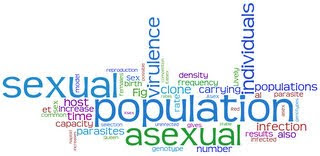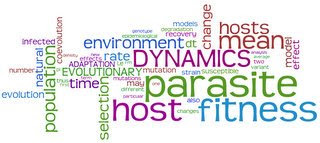
Providing evidence that supports the role of parasites driving the maintenance of sex (i.e. the Red Queen hypothesis) has been a challenge ever since it was proposed. Both theoreticians and empiricists have tackled this hypothesis with vigor to mixed results. This week we read Lively (2009) which focuses on a singular effect to help build a theoretical argument for the Red Queen, density-dependent virulence. Here virulence is defined as the effect of the parasite on the host population growth rate. The density-dependent part comes into play in that the virulence increases with host population size.
The main argument of the paper is that as an asexual population invades a sexual population, the level of virulence changes and this can in turn change the outcome of the overall winner. Parasites with large density-dependent effects can change the balance and allow the maintenance of sexual populations. Presented in several graphs, virulence is a population measure of the effect of the parasites on the hosts. I'm still curious about the magnitude of selection on the individual genotypes in the model. When interpreting the results of this model, I was only able to see what happens when a group of asexual organisms invades a sexual one.
Lively provides an excellent ion description and understanding of the cost of sex. Of course the cost of sex has been detailed before, but the mathematical explanation helps with a basic intuition. The model described in the paper identifies two populations of hosts: asexual and sexually reproducing individuals. What he identifies is that in a sexual population, males provide little and females must produce at least two offspring to replace themselves. These males are using up resources. They are also decreasing the overall density of hosts that could be achieved in a complete female (or asexual) population.
One of the topics that came up during out discussion was how sex ratio may change or evolve during the evolution of sex. The simulation results presented in Lively (2009) assumes a sex ratio of 50/50 which makes sense in an evolutionary context. This has the effect of setting the advantage of the asexual population to be two fold over the sexual population. What happens when instead of two separate populations that do not interbreed, we have females choosing to produce offspring via sex or parthenogenesis? Will rare males in such a population change the early dynamics enough to produce different results?
References
Lively, C. M. 2009. The maintenance of sex: host-parasite coevolution with density-dependent virulence. J Evolution Biol 22:2086-2093.
LIVELY, C. (2009). The maintenance of sex: host-parasite coevolution with density-dependent virulence Journal of Evolutionary Biology, 22 (10), 2086-2093 DOI: 10.1111/j.1420-9101.2009.01824.x







